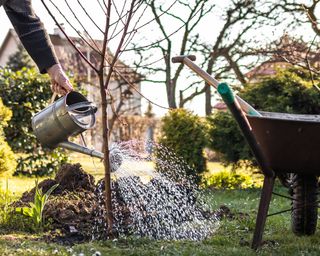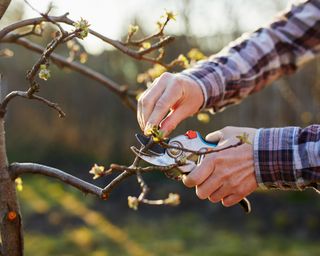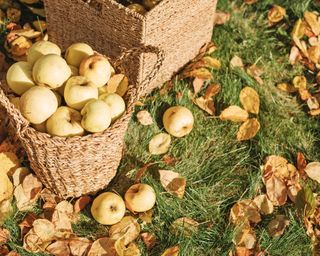As the autumn fruit harvest nears its finish and the leaves start to show and fade, fruit tree homeowners might imagine it is time to let nature take its course and put together their bushes for winter dormancy. Nonetheless, this season is essential for guaranteeing wholesome bushes and bountiful harvests within the coming yr.
It might seem to be a time to wind down, however fall is definitely one of the vital necessary durations when rising fruit bushes. Whereas winterizing fruit bushes ought to type a necessary a part of your fall backyard to-do listing, widespread errors throughout these months can result in severe setbacks.
We requested fruit tree knowledgeable, writer, and founding father of Orchard Folks, Susan Poizner to share her insights on the highest errors individuals make when caring for fruit bushes within the fall – and find out how to keep away from them.
Whether or not you’ve gotten a single apple tree in your yard or a mini orchard, taking the time to grasp and handle these seasonal missteps can stop widespread fruit tree illnesses, pest infestations, and even fruit loss.
From improper fruit tree pruning to neglecting important soil care, Susan’s suggestions present a sensible method to fall tree care that can preserve your fruit bushes wholesome, resilient, and able to thrive when spring returns. Keep away from these widespread fall care pitfalls and provides your fruit bushes the very best likelihood to flourish.

1. Not Watering
Within the fall, fruit tree development slows, so many individuals cease watering, unaware of how necessary hydration is for winter fruit tree survival.
“Bushes which can be well-watered earlier than winter have cells filled with water, which helps insulate these cells and reduces the danger of freezing,” explains Susan. “Dehydrated cells are extra weak to frost, and after they freeze, they will burst, inflicting irreversible harm to the trunk and branches.”
Proceed watering fruit bushes till a number of weeks earlier than the bottom freezes, however cease earlier than freezing temperatures to keep away from ice forming across the roots.
2. Leaving Roots Unprotected
“Mulching bushes is important for shielding delicate roots from freezing and dying throughout the winter, and two inches of wooden chips or arborist mulch is good,” says Susan.
“Lay the mulch in a donut form a number of inches away from the trunk to forestall rot and develop the mulch circle to the sting of the cover if potential as a result of that’s the place the important ‘feeder roots’ are situated.”
When mulching bushes within the fall, keep away from utilizing compost, as it may break down too shortly and stimulate development when the tree ought to be going dormant.
“Additionally, be cautious with thick layers of straw, which may appeal to rodents which will nest in it and harm your tree by chewing on the bark,” provides Susan.

3. Pruning within the Fall
Though it might be tempting to prune fruit bushes within the fall, Susan believes that is the worst time to do it. “Pruning within the fall is a nasty thought as a result of your tree is preparing for dormancy, so the injuries gained’t heal correctly,” she explains. Plus, autumn pruning can set off tender new development that’s simply broken by chilly winter climate.
“Spring and summer season are significantly better choices. Early spring pruning promotes robust development in younger bushes, whereas early to mid-summer pruning when the tree is concentrated on fruit improvement quite than rising new shoots, helps preserve bushes smaller.
“Skipping fall pruning helps keep away from frost harm and reduces the danger of pests and illnesses.”
4. Making use of Industrial Fertilizers
Susan believes that fertilizing fruit bushes with robust industrial merchandise could cause long-term harm and that gardeners ought to take a pure method as an alternative.
“Industrial fertilizers bypass the pure soil organisms that break down natural matter and feed your bushes,” she says. “Utilizing these fertilizers could cause these helpful microbes to die off, leaving your bushes depending on synthetic vitamins. It’s costly, disrupts the soil steadiness, and isn’t sustainable.
“Everybody’s soil is totally different. If you happen to seize a industrial fertilizer like a 10-10-10 combine, it won’t be what your soil wants. Including pointless vitamins can truly hurt your soil and severely harm your fruit bushes. That’s why I recommend avoiding industrial fertilizers except a soil check reveals a particular nutrient deficiency. In that case, select the appropriate fertilizer to deal with simply that deficiency.”
As an alternative of utilizing industrial merchandise to fertilize fruit bushes, attempt boosting vitamins with a easy annual feeding in early spring with a layer of compost or well-rotted manure. Even higher, study find out how to compost at dwelling.
“Unfold it about two inches thick across the roots of your fruit tree, however preserve it away from the trunk to forestall rot,” says Susan. “You can even mulch within the fall, however solely after the tree has gone dormant.”

5. Not Gathering Fallen Leaves or Fruit
Leaving fall leaves on the bottom has develop into a preferred low-maintenance resolution lately, with the concept they’ll decompose and function a pure mulch and fertilizer. Nonetheless, Susan believes gardeners ought to suppose twice in relation to their fruit bushes.
“Fallen leaves is usually a good supply of vitamins – however provided that they’re wholesome. If they’re diseased or infested with pests, you’re principally giving these pests and illness spores a comfy place to overwinter. Within the spring, these pathogens and pests will multiply and return with a vengeance,” she explains. “Many fruit tree illnesses overwinter and unfold. Studying to acknowledge these indicators permits you to nip them within the bud.
“If you happen to’re not nice at recognizing and figuring out illness signs, it’s higher to play it protected and choose up any natural matter round your fruit bushes.”
Widespread illnesses to look out for embody apple scab, rust on apples and pears, fireplace blight on apples, and black knot on cherries and plums.
One other situation is leaving fallen fruit on the bottom. “Fallen fruit attracts pests like wasps and rodents, so cleansing up helps preserve these undesirable guests away,” explains Susan.
6. Leaving the Trunk Uncovered
To overwinter fruit bushes, Susan believes it’s necessary to guard their trunks from winter solar harm and from pests.
“Winter solar can harm fruit tree trunks by inflicting them to develop throughout the day and contract at night time, resulting in cracks that permit pests and illnesses to enter,” she explains. “You may shield your tree by getting ready prematurely. One possibility is to paint the trunk with a 50/50 mixture of white latex paint and water which can replicate the sunshine. Alternatively, you should use white spiral tree guards accessible on-line, or you possibly can wrap the trunk in kitchen foil for the winter.
“These strategies replicate the solar and shield the bark. Keep in mind to take away the plastic guards or foil in early spring, otherwise you would possibly discover bugs breeding beneath.”

